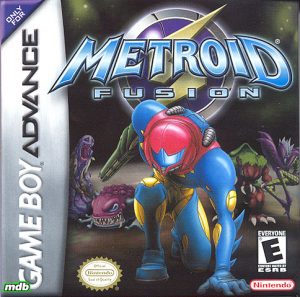 Review by: TJ Rappel
Review by: TJ Rappel
Original Publish Date: Pending
Final rating: “Metroid Fusion will likely act as a lynchpin to the future of the series.”
 When I was at E3 2001 and I saw video footage of the in-development Metroid IV, I was amped. True, the graphics had a long way to go at the time, but when seen in motion, it was obvious that the developers were planning on taking Metroid gameplay to places it hadn’t been before. A year and a half later, we finally have the game, now titled Metroid Fusion, and the Metroid series has indeed been taken to new places — and they are very different places than anyone could have dreamed of.
When I was at E3 2001 and I saw video footage of the in-development Metroid IV, I was amped. True, the graphics had a long way to go at the time, but when seen in motion, it was obvious that the developers were planning on taking Metroid gameplay to places it hadn’t been before. A year and a half later, we finally have the game, now titled Metroid Fusion, and the Metroid series has indeed been taken to new places — and they are very different places than anyone could have dreamed of.
How would they continue the Metroid series after the Metroids had been destroyed in Super, we asked? The answer: Anywhere Nintendo darn well pleases.
Graphics and Design
The same team which developed the first three Metroids created Fusion, as well. They took a bold step in replacing Samus’ classic Power Suit with the very different Fusion Suit, giving our girl a sleeker, more organic, even feral appearance. It might not be as tough-looking as the good ol’ Power Suit, but I still like it. And it makes sense, given that Samus is forced to fight the SA-X — a clone of Samus at her most powerful. The Fusion Suit gives the real Samus a dramatic contrast to her enemy.
The backgrounds and enemies are superbly detailed and somewhat more colorful than those in most Metroid games. Considering the setting of the game, which is a research space station which simulates six different habitats for creatures, this makes sense — not to mention easier viewing on the GBA screen.
Another nice touch is the addition of hand-drawn art in the game’s cutscenes…oh wait, did I mention there are cutscenes? Well there are, and they’re lovely. I would love to get ahold of copies of the original Photoshop files, because the art is beautiful — much more elaborate than the scenes in Super Metroid’s intro sequence.
Control
Fusion’s control is largely a Super Metroid feel with a few additions and deletions. The first thing you’ll notice is Samus’ ability to grab onto ledges and pull herself up, ala Prince of Persia. Much like Metroid II’s addition of a “crouch” position and Super Metroid’s introduction of the wall-jump technique, it’s extremely useful and you’ll wonder why they didn’t think of it before; when playing the older games again, you’ll wish it was there. The wall-jump technique from Super does return, although it’s somewhat modified — no more scaling a single sheer wall to gain that power-up a little early. It’s kind of a bummer, but I bet the programmers did that for the same reason they stopped having bubble doors close automatically after the original Metroid — because Metroid masters found out how to exploit it. Bombing techniques have changed — no more bomb climb, but you don’t really need it since the High-Jump and Spring Ball powerups are now combined in a 2-for-1 item; plus, Sam can lay 4 bombs instead of 3, so the tradeoff isn’t so bad. Finally, climbing on certain walls and ceilings has basically replaced the Grappling Beam, which is okay — no power-up required. There are a few other things they changed regarding the physics of jumping, running, and rolling into a ball, but they’re negligible differences from previous games. All of these changes make playing Fusion slightly different, but no less enjoyable, than Super. With just a few minutes’ practice, any Metroid veteran will be able to navigate Samus through her surroundings as gracefully as ever.
As for Samus’ weaponry, it too is a little different from past installments in the series. While Samus’ beams combine with each other every time you gain a new one, the player is not able to turn each individual weapon on and off as we could in Super. This doesn’t seem to be a problem, however, as the beams simply get stronger — there’s really no need to switch back to an earlier beam. Samus still gets her missiles and power bombs, but in a new twist, her missiles get upgraded through the game. The addition of Ice and Diffusion Missiles is interesting, but no less effective. I have mixed feelings on the game’s system of holding the R button to switch to missiles. While it is easy enough to use, and a little quicker (and safer) than moving your thumb from the control pad to press Select like the other Metroid games, I think I still prefer being able to switch them on and off with one touch of the button, rather than having to hold R throughout a boss battle. An option to control this would have been nice.
Gameplay
By now you’ve probably heard that Metroid Fusion is somewhat more linear than other Metroid games. This is true, although on your way to get where you need to be, there is still the freedom to take your time and poke around. I think of it not so much as being “linear” or “mission-based” as it is “focused.” Samus has a computerized CO which she takes orders and objectives from, so there’s no running around aimlessly, wondering what to do next. Some may argue that that’s half the fun of the old Metroid games, and I am inclined to agree. However, since Fusion is a little more story-driven (thanks to the orders from your CO and those cutscenes I mentioned earlier) than other Metroid titles, I think this system works well. Should the series continue in that fashion? Maybe, maybe not. It doesn’t seem like it would work until you play it, so who knows. They made a Metroid in first-person, so taking a few orders from Adam the computer (no relation to the old Colecovision-based model, I’m sure) shouldn’t be too shocking.
One strange thing I’m noticing is that players seem to find Fusion either too easy or too hard. I found it to be both, actually. Finding your way around, solving the puzzles, and making progress are easy tasks. The bosses and enemies have patterns and identifiable attack techniques, which some may say makes them easy, as well. However, the enemies in Fusion all seem to do an absurd amount of damage to Samus, which can make it rather difficult. Even with the addition of the Varia and Gravity Suits, Samus’ energy tanks are depleted shockingly fast, it seems. The only thing you can do is suck it up and hone your skills. Doing so will require the try, try again method, but it pays off before too long.
Overall, the game is quite short — most players will finish it in 4-6 hours on their first play. The fastest completion of Fusion I’ve heard of as of this writing is about 1:30, which is about the same as a skilled veteran can comfortably complete Super Metroid with a fair amount of powerups and items collected. However, in an interesting twist, it’s been found that Fusion can actually be completed by picking up only ONE power up (you must get at least one pack of missiles). Yes, Fusion can be finished with only 1% item collection, but it’s not easy. In summary, once the game is beaten, there are still challenges which can be taken on, and different ways to play through it, which greatly increases Fusion’s replay value.
Overall
Metroid Fusion should certainly satisfy those who have been waiting for a true follow-up to Super Metroid. It’s a blast to play, very addictive and engrossing, and you can bomb your way through secret passages ’til the cows come home. I found that just using the old “Metroid instinct” — that is, the uncanny ability to find secret passages and hidden features that we old Metroid vets have developed over the years — is extremely rewarding. Acting on the hunch that the dead end in front of you hides something by bombing it and actually finding a secret passage inside which leads to one more Missile or Energy Tank…that’s like Christmas for the longtime Metroid fan. And Fusion is so full of false walls, secret paths and hidden goodies that anyone who already knows Zebes and SR388 inside out will feel like a kid in a candy store checking them all out.
After all these years, we finally got two more Metroid games. Both are a little different from what we’re used to; both bring new concepts to the Metroid series, and both are very, very welcome additions to the franchise. While Metroid Prime took the game’s format in another direction, Metroid Fusion took its story to new places. And as the direct successor to Super Metroid (as the introduction clearly states, Fusion is indeed still “Metroid 4”), we can only wonder where Samus’ fate will take her next. Metroid Fusion will likely act as a lynchpin to the future of the series.
